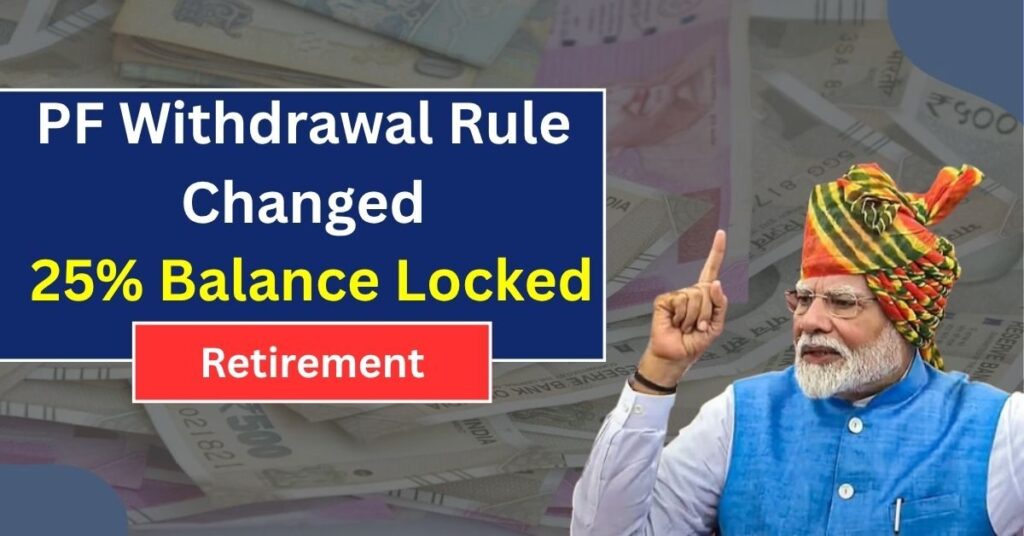Imagine building your future, brick by brick, through every paycheck. Your Provident Fund (PF) is the foundation, silently growing while you focus on career and family. But what happens when life’s big moments or crises demand instant funding? In 2025, the answer to that question has evolved. Recent amendments to the PF Withdrawal Rule mean your safety net is now more accessible—yet smarter about protecting your retirement. Here’s everything you must know if you want to withdraw from your PF after the latest regulatory overhaul.
What’s Changed in the PF Withdrawal Rule?
- The Employees’ Provident Fund Organisation (EPFO) now allows you to withdraw up to 100% of your eligible PF balance for specific needs. However, 25% of your corpus must always remain in the account; this ensures that you continue to grow your retirement fund.
- The list of withdrawal reasons, which used to be spread across 13 categories, is now streamlined into three broad heads: essential needs (like illness, education, or marriage), housing needs, and special circumstances (such as unemployment, epidemics, or natural disasters).
- Service period requirements are now standard: you only need to complete 12 months (one year) in service to be eligible for a partial withdrawal, making access easier even for new employees.
- The number of times you can withdraw for education has increased to 10, and for marriage up to 5—an increase from the previous combined limit of 3 withdrawals.
- You no longer need to furnish elaborate proofs or justifications for special circumstance withdrawals. A self-declaration is enough, reducing paperwork and delays.
Why the rules changed
The aim is to improve “ease of living” for EPF members: quicker, simpler, more predictable access when money is truly needed, without letting short-term withdrawals hollow out retirement savings. The consolidation of 13 categories into three, along with a 25% retention floor, reflects this balance between flexibility and future security.
What counts as “essential,” “housing,” and “special”
- Essential needs: illness, education, and marriage are explicitly grouped so members face fewer hoops and clearer limits. This merges multiple older clauses into one streamlined pathway.
- Housing needs: buying land or a home, building, or paying home loan EMIs fall under this unified umbrella to simplify documentation and limits.
- Special circumstances: a broader, simplified bucket designed to reduce paperwork and speed up approvals when members face atypical or urgent needs.
The Process: Simpler and More Digital
- Application and settlement are now highly digital—most claims can be processed using your UAN (Universal Account Number) linked with Aadhaar.
- Document requirements have dropped; for most partial withdrawals, self-declaration suffices. For full or final settlements, relevant employment termination or retirement proofs are required.
- For final withdrawal, the waiting period after job loss has increased to 12 months (from 2 months earlier). For EPFO pension funds, the withdrawal wait extends up to 36 months of unemployment.
Protection for Retirement
- The mandatory retention of at least 25% of the PF corpus helps ensure you don’t deplete your savings—a critical check as government data shows that many retire with very low balances.
- Interest will continue to accrue on the retained balance, meaning your savings keep compounding for the future.
Key Benefits and Important Caveats
- Employees have more flexibility for genuine needs, but the reforms also discourage reckless withdrawals, keeping the essence of PF as a retirement safety net intact.
- With digital settlements becoming the norm, claim processing is faster, often removing the need for employer intervention.
- The process for buying property with PF funds remains robust: you can now withdraw up to 90% of the account balance for land or housing loan repayments.
Summary Table of the New PF Withdrawal Rules
| Feature | Previous Rule | New Rule 2025 |
|---|---|---|
| Full withdrawal | Only after retirement/unemployment | 100% allowed for specific needs, 25% must remain |
| Partial withdrawal categories | 13 categories | 3 simplified heads |
| Min. service period | 2-7 years | 12 months |
| Marriage/Education withdrawals | Combined 3 times | 10 for education, 5 for marriage |
| Proof required | Multiple, often strict | Self-declaration for most cases |
| Final claim after job loss | 2 months | 12 months |
Calculate Your Redirement plan, Free Career Notice
Conclusion
The “PF Withdrawal Rule Changed” update of 2025 opens new doors for India’s salaried employees—enhancing emergency flexibility while embedding a safety net for retirement. Stay informed, use withdrawals wisely, and let your PF work harder for your future.




